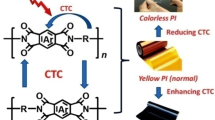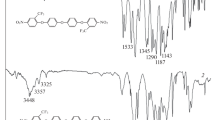Abstract
A series of poly(o-hydroxy amides) were prepared by polycondensation of 3,3ʹ-methylenebis(6-aminophenol) with isophthaloyl chloride or 2-(4-carboxyphenyl)-1,3-dioxoisoindoline-5-carboxylic acid dichloride, and also by copolycondensation of mixtures of this diamine and 4,4ʹ-diaminodiphenyl ether or 1,3-bis(4-aminophenoxy)benzene with isophthaloyl chloride. The properties of the products obtained were studied. Thermal cyclization of poly(o-hydroxy amides) yielded the corresponding poly(benzoxazoles). A film of the poly(o-hydroxy amide) derived from 3,3ʹ-methylenebis(6-aminophenol) and 2-(4-carboxyphenyl)-1,3-dioxoisoindoline-5-carboxylic acid dichloride with 50% elongation at break remains plastic (the enlongation at break exceeds 6%) even after the heat treatment and closure of benzoxazole rings; the elastic modulus of such film is 1.2 times higher than that of the poly(o-hydroxy amide) film containing 1,3-bis(4-aminophenoxy)benzene and isophthaloyl chloride moieties. Formulations allowing formation of an adhesion-strong highly heat-resistant relief with the micrometer size of elements and high dielectric parameters on semiconductor substrates were prepared by adding a photosensitive component of naphthoquinone diazide type to poly(o-hydroxy amide) reactive solutions in 1 : 5 ratio relative to the dry polymer.





Similar content being viewed by others
REFERENCES
Рhotochemistry and Photophysics of Polymer Materials, Allen, N.S., Ed., New Jersey: Wiley, 2010.
Yudin, V.E. and Svetlichnyi, V.M., Polym. Sci., Ser. C, 2016, vol. 58, no. 1, pp. 16–25. https://doi.org/10.1134/S1811238216010124
Tanaka, Т., IEEE Trans. Dielectr. Electr. Insul., 2005, vol. 12, no. 5, pp. 914–928. https://doi.org/10.1109/TDEI.2005.1522186
Iwashita, K., Photopolym. Sci. Technol., 2017, vol. 30, no. 2, pp. 225–230. https://doi.org/10.2494/photopolymer.30.225
Ebara, K., Shibasaki, Y., and Ueda, M., Polymer, 2003, vol. 44, no. 2, pp. 333–339. https://doi.org/10.1016/S0032-3861(02)00784-X
Ueda, M., Ebara, K., and Shibasaki, Y., J. Photopolym. Sci., 2003, vol. 16, no. 2, pp. 237–242. https://doi.org/10.2494/photopolymer.16.237
Lebedeva, G.K., Bazhenova, A.S., Rudaya, L.I., Gofman, I.V., Marfichev, A.Yu., Bol’shakov, M.N., Sokolova, I.M., Chigirev, D.A., Ramsh, S.M., and Shamanin, V.V., Russ. J. Appl. Chem., 2016, vol. 89, no. 10, pp. 1647–1654. https://doi.org/10.1134/S107042721610013X
Patent RU 2602489, Publ. 2016. https://patents.google.com/patent/RU2602489C1/en
Patent RU 2522604, Publ. 2014. https://patents.google.com/patent/RU2522604C2/en
Patent RU 2505579, Publ. 2014. https://patents.google.com/patent/RU2505579C1/en
Strelina, I.A., Rudaya, L.I., Okatova, O.V., Bol’shakov, M.N., Marfichev, A.Yu., Lebedeva, G.K., Shagayko, Yu.V., and Ramsh, S.M., J. Wuhan Univ. Technol.–Mater. Sci. Ed., 2020, vol. 35, no. 1, pp. 223–230. https://doi.org/10.1007/s11595-020-2247-z
Koton, M.M., Gusinskaya, V.A., Svetlichnyi, V.M., Batrakova, E.V., Romashkova, K.A., Kudryavtsev, V.V., Smirnova, V.E., and Ivanova, T.V., Vysokomol. Soedin., 1980, vol. 22, no. 10, pp. 760–763.
Gusinskaya, V.A., Koton, M.M., Batrakova, E.V., and Romashkova, K.A., Vysokomol. Soedin., Ser. A, 1976, vol. 18, no. 12, pp. 2681–2686.
Mait, S. and Ray, A., J. Appl. Polym. Sci., 1983, vol. 28, pp. 225–239. https://doi.org/10.1002/app.1983.070280120
Funding
The study was supported by the Ministry of Science and Higher Education of the Russian Federation (government assignment 0785.00.Х6019).
Author information
Authors and Affiliations
Contributions
M.N. Bol’shakov, G.K. Lebedeva, A.Yu. Marfichev, and L.I. Rudaya: synthesis of polymers and preparation of samples for the studies and formulation and study of photosensitive composites; I.V. Gofman: evaulation of the heat resistance and mechanical characteristics of the polymers in powders and films; I.M. Sokolova and D.A. Chigirev: sample preparation and study of the electrophysical properties of the films; S.M. Ramsh: analysis and theoretical substantiation of the experimental data obtained.
Corresponding author
Ethics declarations
The authors declare that they have no conflict of interest.
Additional information
Translated from Zhurnal Prikladnoi Khimii, No. 4, pp. 490–500, March, 2022 https://doi.org/10.31857/S0044461822040107
Rights and permissions
About this article
Cite this article
Bol’shakov, M.N., Lebedeva, G.K., Marfichev, A.Y. et al. Highly Heat-Resistant Poly(Amido Hydroxy Amides) with Increased Elongation at Break and Photosensitive Formulations Based on Them. Russ J Appl Chem 95, 551–560 (2022). https://doi.org/10.1134/S1070427222040115
Received:
Revised:
Accepted:
Published:
Issue Date:
DOI: https://doi.org/10.1134/S1070427222040115




